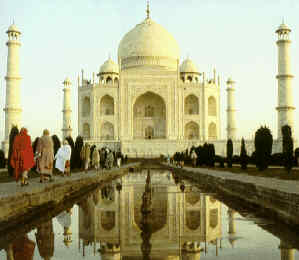


 |
 |
 |
 The Gateway Of India built in 1911 to welcome King George V and Queen Mary.  Chhatrapati Shivaji Terminus Railway Station was previously known as Bombay Vicotoria Terminus (V.T.) It is the Central Railway Station in Bombay with famous new-gothic structure of the world built in 1988.  Taj Mahal, Agra. A Poem in Marbles. One of the 7 Wondors of World! |
India has proved an irresistible attraction to the West - at least since Alexander the Great's day in the 4th century BC. In the mid-1960's, India came to lie at the end of the "hippie trail", a route travelled by thousands in search of themselves, the exotic, and perhaps, the unknown. The fascination of India and everything Indian, whether borne of ancient or not so ancient history is more apparent than ever today. India has, in a sense and on an unparalleled scale, recently "travelled" West in the form of the Festival of India and in the beautiful and hugely successful The jewel in the Crown television series based on Paul Scott's novels. Chess, the curry - and some argue, even rice - the modern written character, Buddhism, yoga, the veena and the sitar in no particular order of merit - are just a few of India's gifts to the world. The changing face of public education, the Green and technological revolutions and the dynamism of the handicrafts industries are further evidence of the flourishing state of one of the world's most ancient and complex civilizations. All India, in a collection of essays accompanied by hundreds of stunning photographs, presents a panorama of Indian everyday life and culture. It shows Indians at prayer, at table, at work and at play; it illustrates the skills of ancient engineers, the craft of the stonemason, the metalworker and the weaver; the reverence for literature, the idolizing of film stars, the passion for music and dance; the working relationship with the camel; in short, the diversity, colour, excitement and spontaneity of India. The introduction looks at the extraordinary dominance of Hinduism, the social mores of family and friends, aspects of village life and the veneration of elephants. The section on form ranges across the pre-Aryan traces of the Harappa civilization, sacred and domestic architecture and sculpture, the garden, and the splendour of Mughal palaces. Friezes, miniatures, frescoes, woodwork, tantras and jewellery and other elements of India's artistic traditions are glimpsed. The emergence of native literature and India as a source of inspiration for foreign writers, the popularity of nataka, total theatre involving music, dance and drama, and the birth of- the Indian film industry are shown in the historical and modern context. The philosophical origins of yoga and the principles of ayurvedic and unani medicine are explained. The story is told of beautiful ritual and domestic objects, fashioned from the most basic materials by artisans whose skills have been handed down from generation to generation. Cottons and luxurious silks are woven into magical saris; bronze is cast to represent Shiva Nataraja in the cosmic dance. Alternative and space technologies coexist side by side. The legacy of the British and the growth of media networks are revealed as just two strands in the complicated process of the development of a national identity. The Indians are identified as passionate game players - flying kites, playing polo, hockey and cricket and horse racing and travellers, whether as pilgrims, tourists or for business, by foot, motor rickshaw, automobile or train. Finally, perhaps that most widely travelled artifact of Indian life, its food, is analysed region by region.
All India is an exiciting celebration of one of the world's most diverse and fecund cultures. It also includes an invaluable listing section giving names and addresses in the US and elsewhere of education and religious centres, retail outlets for Indian resources and products, bookstores, and business organisations, galleries and museums and much more besides. All India illuminates contemporary India and her people and makes riveting reading for all consumers and armchair travellers. (words from the Book: "ALL INDIA" Edited by Reginald Massey) |
An excellent way of sampling this cultural opulence is through Indian cuisine. The process of preparing, serving and eating a meal in India is steeped in ritual. The dishes are subtle, with piquant flavours. There is an endless variety of individual preparations of such pedestrian fare as lentils- of all shapes, sizes or colours: sprouted, green, black, yellow and pink.
There is an old Indian saying which translates as follows, "Give me leave so that I might come again." Five thousand years old India remembers the whispers of many different voices. The Aryans. Greeks, Parthians, Turks, Afghans, Moghuls, Portuguese, Dutch, French and English- the list of arrivals on the shores is never complete. A riot of colour greets you as you arrive. The seasons too, have their journeys iin colour, and the rain changes all that it touches. India ia a land of arrivals, returns and journeys- a continuous voyage. It has defied definition throughout the ages. A search for the essense of India escapes a totality of understanding even for her own citizens. Yet the glowing tapestry of its present owes the magnificent of its textured weave to the variety of strands that have arrived and will journey with her into a common future.
 This intro to India page is being visualised/designed/maintained and updated by Mahendra.
This intro to India page is being visualised/designed/maintained and updated by Mahendra.
Meet me at my own fabulous Home Page.
*FREE* space provided for this Great Page from 
Copyright 1997 : vbmcomputers@yahoo.com
